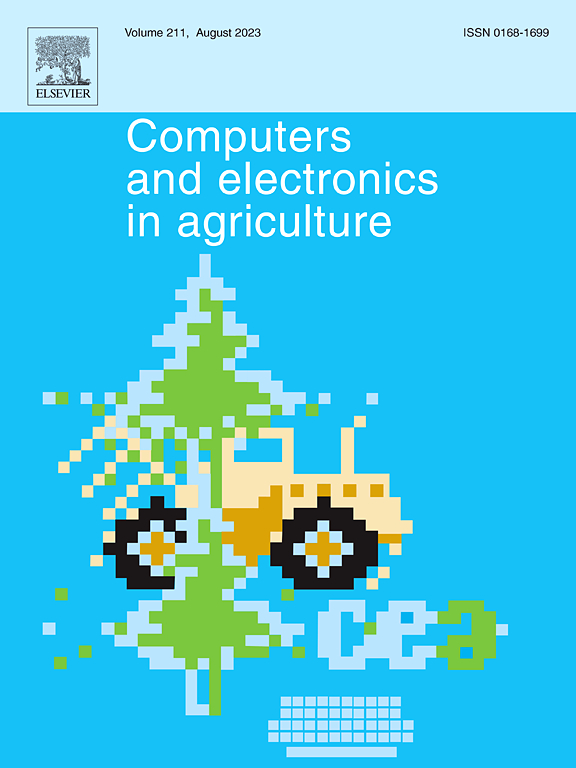UAV multispectral remote sensing for the estimation of SPAD values at various growth stages of maize under different irrigation levels
IF 7.7
1区 农林科学
Q1 AGRICULTURE, MULTIDISCIPLINARY
引用次数: 0
Abstract
Chlorophyll is crucial for photosynthesis in plants and the readings by a SPAD meter (Soil and Plant Analyzer Development) can be used to represent leaf chlorophyll content for monitoring crop growth status and predicting grain yield. Remote sensing technology has shown potential in non-destructive monitoring of SPAD values over large areas, but current SPAD inversion models are limited in their ability to incorporate multiple principal components besides spectral parameters, adapt to other variables such as water stress, and predict SPAD only throughout the entire growth period. This two-year study used crop parameters (plant height and leaf area index) and vegetation indices (VI) derived from unmanned aerial vehicle (UAV) multispectral images to develop SPAD prediction models for maize under different irrigation levels in the 2018 and 2019 growing seasons in Inner Mongolia, China. Two nonlinear machine learning models, random forest (RF) and support vector regression (SVR), and a multiple statistical regression method (partial least squares regression (PLSR)) were used to modeling SPAD. The results showed that the VIs with a high correlation with SPAD varied at each growth stage and the accuracy of SPAD estimation model can be improved significantly by dividing different growth stages (R2 increased by more than 104 %). PLSR performed better than RF and SVR for each growth period, especially at the reproductive R stage (R2 = 0.79, RMSE = 2.25). LAI and PH did not always improve prediction accuracy, but adding crop parameters did increase the correlation coefficient between predicted values and biomass by 8.3 %. This study provides valuable insights into the estimation of SPAD at different growth stages of maize under varying water stress levels using UAV data and crop parameters, offering guidance for farmland management and yield prediction.
利用无人机多光谱遥感技术估算不同灌溉水平下玉米不同生长阶段的 SPAD 值
叶绿素对植物的光合作用至关重要,SPAD 仪(土壤和植物分析仪开发)的读数可用于表示叶片叶绿素含量,以监测作物生长状况和预测谷物产量。遥感技术在无损监测大面积 SPAD 值方面已显示出潜力,但目前的 SPAD 反演模型能力有限,除了光谱参数外,还无法纳入多个主成分,也无法适应其他变量(如水胁迫),而且只能预测整个生长期的 SPAD 值。这项为期两年的研究利用从无人机(UAV)多光谱图像中获取的作物参数(株高和叶面积指数)和植被指数(VI),为中国内蒙古2018年和2019年生长季不同灌溉水平下的玉米建立了SPAD预测模型。采用随机森林(RF)和支持向量回归(SVR)两种非线性机器学习模型以及多元统计回归方法(偏最小二乘回归(PLSR))对SPAD进行建模。结果表明,与 SPAD 高度相关的 VIs 在每个生长阶段都不相同,而且通过划分不同的生长阶段,SPAD 估算模型的准确性可显著提高(R2 提高了 104 % 以上)。PLSR 在每个生长期的表现都优于 RF 和 SVR,尤其是在生殖 R 阶段(R2 = 0.79,RMSE = 2.25)。LAI 和 PH 并不总是能提高预测精度,但添加作物参数确实能将预测值与生物量之间的相关系数提高 8.3%。这项研究为利用无人机数据和作物参数估算不同水分胁迫水平下玉米不同生长阶段的SPAD提供了宝贵的见解,为农田管理和产量预测提供了指导。
本文章由计算机程序翻译,如有差异,请以英文原文为准。
求助全文
约1分钟内获得全文
求助全文
来源期刊

Computers and Electronics in Agriculture
工程技术-计算机:跨学科应用
CiteScore
15.30
自引率
14.50%
发文量
800
审稿时长
62 days
期刊介绍:
Computers and Electronics in Agriculture provides international coverage of advancements in computer hardware, software, electronic instrumentation, and control systems applied to agricultural challenges. Encompassing agronomy, horticulture, forestry, aquaculture, and animal farming, the journal publishes original papers, reviews, and applications notes. It explores the use of computers and electronics in plant or animal agricultural production, covering topics like agricultural soils, water, pests, controlled environments, and waste. The scope extends to on-farm post-harvest operations and relevant technologies, including artificial intelligence, sensors, machine vision, robotics, networking, and simulation modeling. Its companion journal, Smart Agricultural Technology, continues the focus on smart applications in production agriculture.
 求助内容:
求助内容: 应助结果提醒方式:
应助结果提醒方式:


